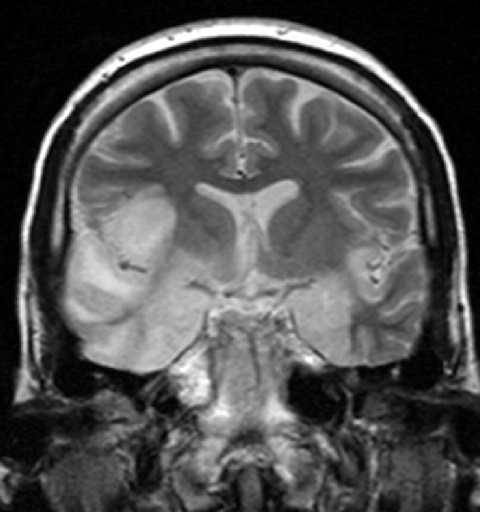Encephalitis refers to inflammation of the brain parenchyma i.e. the actual functional tissue of the brain.
Causes
- Viruses: Viral encephalitis is the most common underlying aetiology
- Herpes simplex virus (HSV) - most common cause of encephalitis, specifically HSV1 (HSV2 also causes encephalitis)
- West Nile virus
- Cytomegalovirus
- Epstein Barr virus
- Enterovirus
- Rabies virus
- Autoimmune encephalitis: These are far less common but can occur.
It is also possible to get fungal, bacterial and parasitic encephalitis.
Clinical Features
A thorough history is important as there may be signs of a preceding viral infection such as a recent upper respiratory tract infection or gastrointestinal infection. Specific presenting features include:
- Headache
- Fever
- Altered mental status
- Neck stiffness
- Photophobia
- Nausea and vomiting
- Myalgia
- Impaired memory
- Seizures: Patients can go into status epilepticus with encephalitis.
- Disorientation
- Personality or behaviour changes
Differential Diagnosis
- Meningitis
- Brain abscess: Seen as a ring-enhancing lesion on imaging
- Haemorrhagic stroke: Haemorrhagic as ischaemic strokes don't usually cause headache
- Intracranial malignancy
Investigations
Bedside
- Observations
- Neurological examination
- Fundoscopy: Looking for papilloedema
Bloods
- FBC, U&E, LFT
- Clotting
- CRP/ESR
- Blood cultures
- Blood glucose
- PCR for N meningitidis: If suspecting bacterial meningitis
Imaging
- CTH: Can be used in an acute setting e.g. in ED to rule out any other intracranial abnormalities
- MRI: Can help visualise oedema of the brain tissue – especially with regards to HSV which often affects the temporal lobes resulting in impaired memory.
dr Laughlin Dawes, CC BY 3.0 , via Wikimedia Commons
T2-weighted MRI from a patient presenting with HSV encephalitis
Special Tests
- Lumbar puncture: This can be useful, especially when considering a differential of meningitis. CSF in viral encephalitis will show a moderate lymphocytosis, moderately high protein and normal glucose.
- CSF PCR: Test for specific viruses e.g. herpes simplex virus
- Gram stain CSF: Exclude bacterial infection
- MC&S CSF: Identify bacterial infection
Management
- Acute patients should be approached with the ABCDE approach (Airways, Breathing, Circulation, Disability and Exposure) in order to first ensure physiological stability.
- Treatment is largely supportive and with intravenous acyclovir for viral encephalitis, although this can change depending on the underlying causative pathogen. There may also be additional cover with antimicrobials such as ceftriaxone to empirically treat for meningitis when a diagnosis is still pending.
References
https://www.rcemlearning.co.uk/reference/intracranial-infections/#1583320391301-8984ea12-be0d
https://www.msdmanuals.com/en-gb/professional/neurologic-disorders/brain-infections/encephalitis
https://www.journalofinfection.com/article/S0163-4453%2811%2900563-9/fulltext#secd13892755e2601
